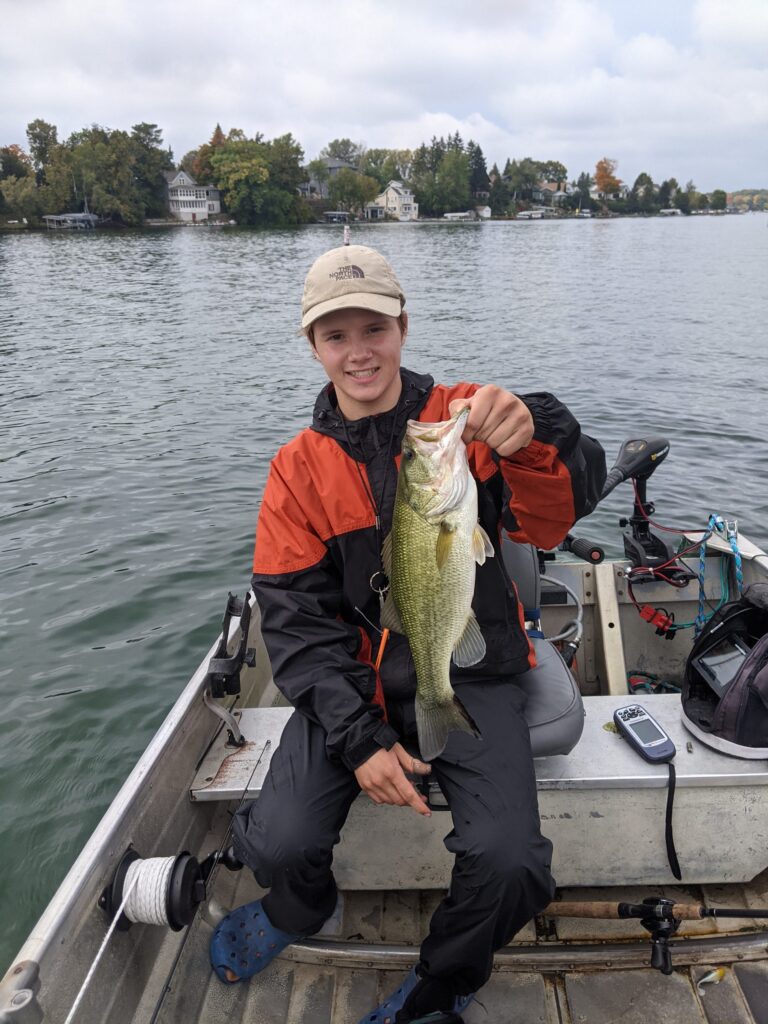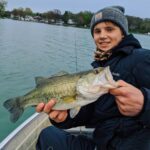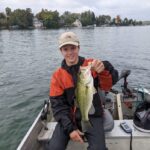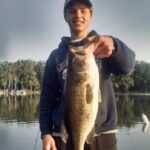Hey there anglers! If you’re anything like me, you’re always trying to expand your fishing arsenal and learn new techniques to help you catch more fish on the water. One lure that every bass angler should know how to fish with is a jerkbait. A jerkbait is an effective lure throughout a majority of the year, and it’s one of those lures that will work sometimes when nothing else will. If you’re ready to up your bass fishing game, you’re in the right place. Whether you’re a seasoned pro or just starting out, this guide will provide you with everything you need to know about how to fish a jerkbait for bass. Lets get started!
Table Of Contents:
Understanding Jerkbait Fishing
Before we get started, it’s important that you understand that basics about jerkbaits
What Are Jerkbaits?
First things first, let’s talk about what a jerkbait actually is. A jerkbait is a hard-bodied lure that is meant to imitate a wounded baitfish. There are several different types of jerkbaits that are designed for various applications and depths. Jerkbaits get their name from the way that you retrieve them. Instead of steadyily retrieving this lure, you use a jerk and pause retrieve.
Why Fish a Jerkbait?
Now, you might be wondering why jerkbaits are so effective for bass. Jerkbaits have many several advantages over other lures that make a huge difference at certain times of the year. One of the biggest advantages is their ability to trigger bites. The quick jerk and almost instantaneous pause is very unique to this lure. When the jerkbait stops perfectly still in the water in front of a bass, it’s too much for them to resist a lot of the times.
When To Fish A Jerkbait For Bass
Now that you know what a jerkbait is and what makes it effective, let’s discuss when the best times to fish it are
Water Temperature and Seasonal Patterns
First lets talk about timing as it relates to water temperature and seasonal patterns. In general, jerkbaits excel when the water temperature is cooler. Spring, fall, and winter are all great times to fish for bass with a jerkbait. Why? Because the cooler water temperature decreases bass activity. As mentioned earlier, jerkbaits have the ability to sit still for long periods of time which triggers a lot of fish into biting these times of the year.
Suspended Fish
Another great time to tie on a jerkbait is when the bass are suspended in the water column. Jerkbaits are typically fished higher in the water column and bass swim up to hit them. When bass are suspended, they are looking upwards a lot of the times in search of their next meal. Take advantage of this and fish a jerkbait several feet above these fish, and you’ll be surprised how effective it can be at all times of the year.
Clear Water
Jerkbaits are a very visual technique, meaning that they rely on bass to see the lure. In addition, the sudden movement of the lure is often what triggers a bite. For that reason, jerkbaits excel when fishing clear water. In fact, the clearer the water the better in my opinion. Avoid fishing jerkbaits in dirty water since bass will not be able to adequately locate the bait.
Essential Gear for Jerkbait Fishing
The jerkbait is one of those lures that requires specialized gear to effectively fish, but don’t worry, we’ve got you covered.
Rod
Choosing the right jerkbait rod is crucial for success. I recommend choosing a medium power baitcasting rod for this technique. Baitcasting rods are ideal since they are much more comfortable than spinning rods to impart the necessary action to the lure. The medium power is important since it allows enough give to cast and retrieve the jerkbait appropriately and to keep the treble hooks pinned when a bass strikes. As far as length goes, I recommend choosing a jerkbait rod between 6’6″ and 7′ in length. The slightly shorter length allows you to keep the rod tip downwards throughout your retrieve, but feel free to choose a length that feels best for you.
Fishing Line
Fishing line is probably just as important as your rod when it comes to jerkbait fishing. The two main lines to use are fluorocarbon or monofilament. 8-12 lb test is a good starting point for this technique. The reason that these two lines are king is that they have stretch, which is crucial when fishing treble hooked baits. The benefit of fluorocarbon is that it is practically invisible in the water. The benefit of monofilament is its overall fishability. Keep in mind that fluorocarbon sinks and monofilament floats since this can change the action of your jerkbait under water. Experiment with these two types of lines and ultimately it comes down to personal preference.
The Main Types Of Jerkbaits
The three main types of jerkbaits for bass are floating, suspending, and sinking
Floating
Floating jerkbaits float when they are paused in the water column. When you jerk them, the bill pulls the lure downwards in the water. Floating jerkbaits typically run within a few feet of the surface. Floating jerkbaits are ideal for fishing in shallow water or when fish are feeding close to the surface.
Suspending
Suspending jerkbaits are probably the largest category of jerkbaits when it comes to bass fishing. As the name implies, these jerkbaits suspend in the water column when they are paused. Suspending jerkbaits are ideal for fishing cold water for this reason. You have the ability to let the bait sit still as long as you can stand before jerking it again. This is the key to triggering lethargic bass in the cooler months a lot of the times. Choose a suspending jerkbait that runs a few feet higher than the fish are sitting at. For example, it the fish are in 15 ft, use a jerkbait that runs around 10 feet down.
Sinking
The sinking jerkbait is much less common for bass fishing, but still has a time and a place. When a sinking jerkbait is paused, and sinks through the water column. This comes into play when fishing bass in deep water. Once you figure out the drop-rate, you can count down your lure and effectively fish it at any depth.
How To Fish A Jerkbait
Now that you’re set up with the right gear and jerkbait for the job, let’s talk about how to fish it
The Jerk and Pause Retrieve
In order to fish a jerkbait for bass, you’ll need to master the jerk and pause retrieve. This retrieve consists of holding your rod in the downward position, sharply jerking your rod tip, and letting the bait sit still. After jerking the lure, it is critical to let the bait sit still on slack line to prevent any excess movement of the lure. You want it to stop perfectly still immediately after the jerk. Almost all of your bites will occur when the bait is sitting motionless in the water. Watch your line closely and look of for any sort of line jump. If your line jumps, simply reel and lean into the fish to set the hook. No need for a sweeping hookset in this case.
Varying Cadences
Jerkbaits are all about cadences. Bass aren’t always in the same mood, so don’t get stuck fishing your jerkbait the same way every time. Experiment with different cadences. Change the number of times you jerk the rod tip before pausing it and change the length of pauses as well. As a general rule of thumb, the cooler the water, the longer the pauses. When I say long pauses, I’m talking about upwards of 30 seconds in some cases. Trusts me, it makes a difference.
Jerkbait Modifications
When it comes to jerkbaits, there are various modifications you can do to set your lure apart from the rest
Adding Weight
The two main ways to add weight to a jerkbait is through upsizing your hooks and split rings or adding lead tape. Adding weight to a jerkbait changes its action and fall-rate. For example, you can change a floating jerkbait to a slow float, or a suspending jerkbait to a slow sink. The options are endless. You can even go a step further and add weight to only the front or back of the jerkbait. This allows the jerkbait to fall headfirst or tail first depending on where the weight is located. Experiment and find what works best on the water body you are fishing.
Color
You can make color as complicated or simply as you want. Generally speaking, I don’t get caught up on jerkbait color too much for jerkbaits. For crystal clear water, opt for translucent colors that match the hatch. For slightly dirtier water, chose more bold and solid color patterns. Keep in mind that jerkbaits excel when fishing clear water since it is a very visual technique. Avoid fishing dirty water with jerkbaits, there are better lures for the job.
There you have it – everything you need to know about how to fish a jerkbait for bass. Remember to identify the right times to fish a jerkbait and choose a jerkbait that is best for the job. Experimentation is key when it comes to jerkbait fishing. Whether you’re an experienced angler looking to up your game or a beginner when it comes to bass fishing, jerkbait fishing is a skill worth mastering. So put your newfound knowledge to the test the next time you’re out on the water. Tight Lines!
More Bass Fishing Articles:






